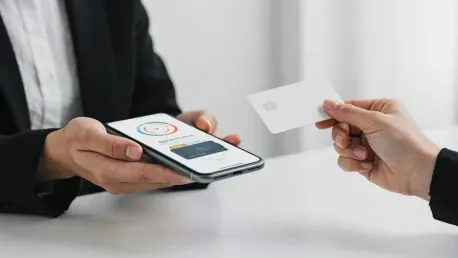In the realm of digital payments, the move toward contactless transactions has brought both convenience and risk, with cybercriminals leveraging sophisticated methods to exploit Near Field Communication (NFC) technology. The rise of mobile payment platforms like Apple Pay and Google Wallet has transformed how consumers manage their finances, yet it has also created new opportunities for fraudsters. By obtaining victims’ card credentials through phishing, these attackers link the stolen information to fraudulent mobile wallet accounts, enabling them to conduct contactless payments using the victims’ funds without needing physical card access. These evolving tactics underscore the urgency of fortifying security measures against increasingly cunning threats.
Tactics and Strategies
Phishing and Credential Theft
The attacks typically start with victims encountering deceptive websites that mimic various services, prompting them to link their payment cards or make small verification payments. Once the card details are entered, they are immediately transmitted to cybercriminals. Researchers at Kaspersky have found that these operations are conducted at an almost industrial scale, with fraudsters acquiring numerous smartphones, creating multiple Apple and Google accounts, and systematically installing contactless payment applications to execute their schemes. The extent of planning and resources dedicated to these operations highlights the significant threat posed by such organized fraud.
Specialized software is used to create perfect digital replicas of the victims’ cards, which are then photographed directly into mobile wallet applications for instant linkage. The efficiency and precision of this process ensure that the fraudulent accounts can be used almost immediately. A significant factor in the success of these attacks is the delay between the initial credential theft and the eventual fund extraction. By the time transactions occur, victims may have forgotten about the suspicious website interaction. These transactions often involve luxury goods purchases in physical stores or NFC-enabled ATM withdrawals, which do not require additional verification.
Industrial Scale Fraud
The sophistication of mobile wallet fraud operations is alarming. Fraudsters strategically use multiple mobile devices and accounts to carry out their activities discreetly, ensuring that each device can operate independently without drawing attention. This systematic approach significantly amplifies the impact of their schemes. Moreover, the ability to create perfect digital replicas of payment cards means that physical card access is no longer necessary, rendering traditional security measures ineffective. The reliance on contactless transactions further complicates detection efforts, as these transactions typically do not require additional verification, allowing fraudsters to avoid scrutiny.
Specialized software used in these operations is specifically designed to replicate payment card information accurately, enabling seamless integration with mobile wallet applications. This ensures that fraudulent accounts are linked and ready for use almost instantaneously. These transactions often go undetected because they resemble regular, legitimate purchases, adding another layer of complexity to identifying and preventing fraud. The delay between credential theft and fund extraction also plays a crucial role, as it reduces the likelihood of victims being alert to the suspicious activity.
Ghost Tap Technique
NFC Relay Technique
A particularly dangerous technique within this fraud ecosystem is the NFC relay technique known as “Ghost Tap.” This involves using legitimate applications like NFCGate on two separate smartphones – one containing the wallet with stolen cards and another used for making the actual payments. The relay application transmits the wallet’s NFC data in real-time over an encrypted internet connection from the first device to the second device’s NFC antenna, which is then used at payment terminals by criminal operatives known as “mules.” This innovative method allows fraudsters to conduct transactions from remote locations without direct physical interaction with payment terminals.
The sophistication of the Ghost Tap technique lies in its ability to maintain signal integrity while relaying across distances, making it hard for payment terminals to distinguish it from a legitimate signal. Even if security personnel apprehend the payment mule, their device only contains legitimate software, with no direct evidence of stolen card credentials, which remain stored on a remote device often located in a different region. This ensures that even if fraudsters are caught during a transaction, the likelihood of tracing the entire fraudulent operation remains low, preserving the integrity of their schemes.
Real-Time Data Transmission
The success of the Ghost Tap technique is primarily attributed to its ability to transmit NFC data in real-time while maintaining signal integrity. This ensures that the relayed data is indistinguishable from genuine contactless transactions, facilitating seamless integration at payment terminals. Criminals utilizing this technique can operate across vast geographical distances without compromising the efficiency or validity of the transactions. The use of encrypted internet connections further secures the transmitted data, thwarting efforts by security personnel and technologies to intercept or decode the fraudulent transactions.
Given the complexity and ingenuity of the Ghost Tap technique, traditional security measures are often rendered ineffective. The legitimate appearance of the software used on the mule’s device complicates the process for law enforcement and security teams to identify and apprehend the perpetrators. In addition, the remote storage of the stolen card credentials means that the primary device responsible for initiating the fraudulent transactions is rarely in proximity to the payment terminals or devices used by the mules, further complicating detection and prevention efforts.
Implications and Solutions
Challenges in Detection
The innovative and industrial nature of modern payment fraud, combining digital elements and physical actions, poses significant challenges for detection and prevention. These sophisticated methods necessitate advancements in security technologies and strategies to identify potential vulnerabilities in mobile payment systems. Law enforcement agencies and cybersecurity experts must collaborate to develop comprehensive approaches aimed at thwarting these evolving threats. Robust cybersecurity measures, advanced detection algorithms, and continuous monitoring are essential to protect against these sophisticated attacks and safeguard consumer information.
Moreover, consumers must remain vigilant and educate themselves on potential phishing schemes and suspicious activity to mitigate risk. Implementing multi-factor authentication, monitoring account statements regularly, and reporting any anomalies to financial institutions are critical steps in protecting personal information. Financial organizations should invest in technologies that enhance transaction monitoring, detect unusual patterns, and promptly alert customers about potentially unauthorized activities. Collaboration between technology providers, financial institutions, and regulatory bodies is imperative to establish a unified front against these advanced fraudulent schemes.
Future Considerations
In the era of digital payments, the shift towards contactless transactions offers both significant convenience and notable risks. Cybercriminals have become adept at exploiting Near Field Communication (NFC) technology, a foundation of mobile payment platforms like Apple Pay and Google Wallet. These platforms have revolutionized how consumers manage their finances by allowing them to make payments with a quick tap. However, this innovation also presents new opportunities for fraudsters.
By employing phishing tactics, cybercriminals acquire victims’ card information, which they then link to fraudulent mobile wallet accounts. This enables them to carry out contactless payments using the victims’ funds, all without needing physical access to the actual cards. The advancing complexity of these fraudulent tactics highlights the critical need to enhance and fortify security measures against such sophisticated threats. As technology evolves, so must our defenses to safeguard against increasingly cunning cybercriminal activities. Therefore, ensuring robust security is more crucial than ever.









